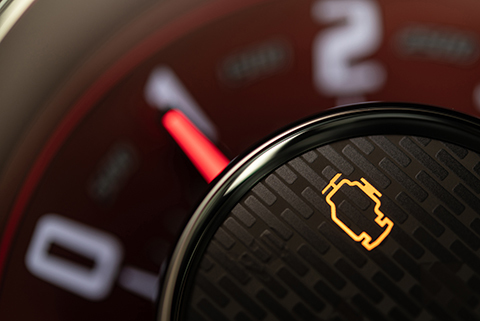INDEPENDENT DEALER
Ann Arbor, MI | (702) 561-3706
Dwight Smith
OUR BLOG
04/11/2025
The check engine light may be mysterious or daunting, but it doesn’t have to be that way. It’s there to help you take better care of your car. This post by Dwight Smith in Ann Arbor, MI will tell you everything you have to know about the check engine light.

Few things cause instant stress while driving like seeing the check engine light (CEL) appear on your dashboard. It’s a vague warning that could mean something isn’t right. While many drivers choose to ignore it, doing so could lead to bigger and more expensive issues. To help you out, read on to learn all about the check engine light.
Avoid the check engine light by calling Dwight Smith in Ann Arbor, MI, at (702) 561-3706 or visiting AMSOIL's online shop and maintaining your car perfectly.
What Does the Check Engine Light Mean?
The check engine light is part of your car’s On-Board Diagnostics (OBD-II) system. It may say “Check Engine” literally, or show you the outline of an engine. It lets you know there’s a problem and how severe it is:
- Solid Check Engine Light – This usually indicates a less urgent issue, such as a faulty sensor or emissions-related problem. You can typically continue driving, but you should diagnose the issue soon.
- Flashing Check Engine Light – A blinking light means a serious problem, like an engine misfire. If this happens, pull over and address the issue immediately.
Common Causes of the Check Engine Light
There are several reasons why your check engine light might turn on. For example:
1. Loose or Faulty Gas Cap
- The gas cap seals the fuel system and maintains proper pressure.
- If it’s loose, missing, or damaged, the fuel system may detect a leak, triggering the light.
- Fix: Check that the gas cap is tightened properly or replace it if it’s cracked.
2. Oxygen Sensor Failure
- The oxygen (O2) sensor monitors the amount of unburned oxygen in the exhaust and helps regulate the air-fuel mixture.
- A bad sensor can reduce fuel efficiency and damage the catalytic converter.
- Fix: A mechanic can scan the vehicle for trouble codes and replace the faulty sensor.
3. Catalytic Converter Failure
- The catalytic converter helps reduce harmful emissions.
- If it fails, your car may produce higher emissions, lose power, or even fail an emissions test.
- Fix: Regular maintenance, like replacing oxygen sensors and using quality fuel, prevent premature failure.
4. Faulty Mass Airflow Sensor (MAF Sensor)
- The MAF sensor measures the amount of air entering the engine and helps determine the correct fuel mixture.
- A bad sensor can cause rough idling, poor fuel economy, and reduced acceleration.
- Fix: Replacing the air filter regularly avoids sensor issues. If the sensor is bad, change it.
5. Ignition Coil or Spark Plug Issues
- Spark plugs and ignition coils are responsible for igniting the air-fuel mixture in the engine.
- Worn-out spark plugs or failing ignition coils can cause misfires, poor acceleration, and engine hesitation.
- Fix: Replace spark plugs according to your car manufacturer’s maintenance schedule.
6. Issues with the EGR Valve
- The exhaust gas recirculation (EGR) valve helps reduce emissions by recirculating some exhaust gases back into the engine.
- A clogged or stuck EGR valve can cause rough idling and performance issues.
- Fix: Cleaning or replacing the EGR valve can resolve the issue.
7. Low Battery or Charging System Problems
- A weak battery or failing alternator can trigger various warning lights, including the check engine light.
- If the battery voltage drops too low, it can cause electronic systems to malfunction.
- Fix: Test the battery and alternator. If the battery is over three years old, consider replacing it.
Keep your engine strong with AMSOIL's Signature Series 0W-20 Synthetic Motor Oil, the best synthetic oil in Ann Arbor, MI.
What to Do When Your Check Engine Light Comes On
If you see the check engine light come on, do the following:
- Check for Immediate Warning Signs. If the car is running rough, overheating, or making unusual noises, pull over immediately. If the light is flashing, avoid driving and have the car towed to a mechanic.
- Tighten the Gas Cap. If the cap is loose, tighten it and see if the light goes off after a few drives.
- Use an OBD-II Scanner. A diagnostic scanner can retrieve the error codes. Or go to an auto shop for a free diagnostic.
- Address the Issue. Fix minor issues yourself and go to a mechanic for more complex problems.
- Reset the Check Engine Light (If Necessary). If the light doesn’t turn off after a few driving cycles, some OBD-II scanners allow you to reset the light manually.
How to Prevent Check Engine Light Issues
Lastly, if you never want to see a check engine light go off again, here are a few measures you can take to prevent just that:
- Follow regular maintenance schedules
- Use high-quality fuel
- Check your battery regularly
- Keep an eye on fluid levels
- Address minor problems quickly
Call Dwight Smith in Ann Arbor, MI, at (702) 561-3706 or visit AMSOIL's online shop to place an order on the top products for your engine’s maintenance.
CONTACT